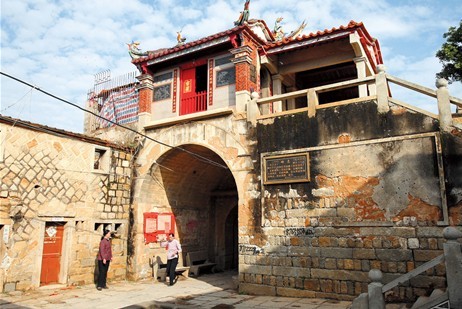 |
|
Local residents walk under the East Gate of Chongwu township in Quanzhou, a coastal city in eastern China’s Fujian province. Chongwu, meaning “advocating defense” in Chinese, served as a military base against invaders from sea, especially from Japan, since 1387 in Ming Dynasty (1386-1644). [Shanghai Daily]
|
Chongwu Old City takes visitors to its ancient zigzag streets back to a time when family temples, traditional marriage customs and veneration of past heroes and ancestors defined a lively happy life. Tom Qian takes a step back in time.
Chongwu, in southeast China’s Fujian province, is a small place compared with other cities famous for ancient walls like Xi’an and Pingyao.
It’s unique, however, because it’s the only complete city wall made with granite in China, and, being a structure to guard against invasion from the sea, it is splendidly situated with three sides facing the water.
Chongwu, meaning “advocating defense” in Chinese, served as a military base against invasion from Japan and other seafaring nations since the beginning of the Ming Dynasty (1368-1644). It is a township-level division of Hui’an county of the prefecture-level city Quanzhou, a scenic city an hour ride away.
Chongwu’s walls are 2,457 meters long, 3 meters tall and 3 meters wide on average. Chongwu Old City was listed as a national relic in 1988 by the State Council, China’s cabinet.
My first impression of Chongwu Old City was that it looked too new — the walls looked bright yellow under morning sun with little grass or few trees growing on it. But that impression faded fast as we immersed ourselves in the life of the authentic old city.
Entering the city from its West Gate and walking along the narrow streets built of stone slabs, you cannot fail to notice all the houses are only one or two floors high and the building material is mostly thick stone.
We walked counterclockwise toward the south to see the main structure of the stone wall facing the sea. On the way, we saw people preparing lunch as dogs, cats and chickens wandered around. Through the open doors of some houses, you could see portraits of ancestors hung in good order on the wall. It was like looking across time seeing the old men and women in the drawings peering back at you.
We recommend:
